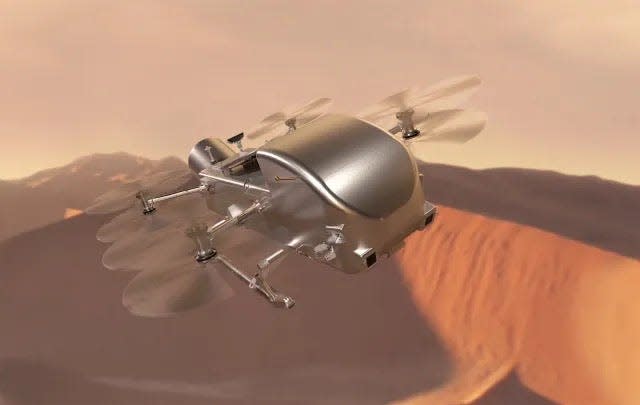'Like a large drone': NASA to launch Dragonfly rotorcraft lander on Saturn's moon Titan
NASA will explore Saturn's "organic-rich moon" Titan using a rotorcraft lander called "Dragonfly," according to the government agency.
Dragonfly will launch July 2028 to explore "diverse locations to characterize the habitability of Titan's environment," NASA said on its website. Before launch, Dragonfly's design will need to be finalized, and the lander will have to be built and undergo testing, the agency said Tuesday in a news release.
“Dragonfly is a spectacular science mission with broad community interest, and we are excited to take the next steps on this mission," Nicky Fox, associate administrator for the science mission directorate at NASA Headquarters in Washington, said in the release. "Exploring Titan will push the boundaries of what we can do with rotorcraft outside of Earth.”

How much will Dragonfly cost?
Dragonfly has a total lifecycle cost of $3.35 billion, NASA said. The rotorcraft is anticipated to arrive at Titan in 2034 and "fly to dozens of promising locations on the moon, looking for prebiotic chemical processes common on both Titan and the early Earth before life developed," according to the agency's release.
"Dragonfly marks the first time NASA will fly a vehicle for science on another planetary body," the government agency said. "The rotorcraft has eight rotors and flies like a large drone."
Dragonfly experienced delays before becoming approved for launch
NASA's mission to Titan passed all the success criteria of its preliminary design review in early 2023, which provides "increased assurance" that the operation will have "minimal project risk," the government agency said. After passing, NASA had to develop an updated budget and schedule that "fit into the current funding environment," according to the release.
NASA's updated plan was conditionally approved in November 2023 pending the outcome of the 2025 fiscal year's budget process, the government agency said. Until then, NASA continued to work on the final mission design to ensure the mission to Titan stayed on schedule, according to the agency.
Dragonfly was confirmed after the release of the president’s fiscal year 2025 budget, NASA said. The mission cost about two times more than the proposed cost and was delayed more than two years from when it was initially selected in 2019, according to the release.
This article originally appeared on USA TODAY: NASA launching Dragonfly mission for rotorcraft lander on Titan

